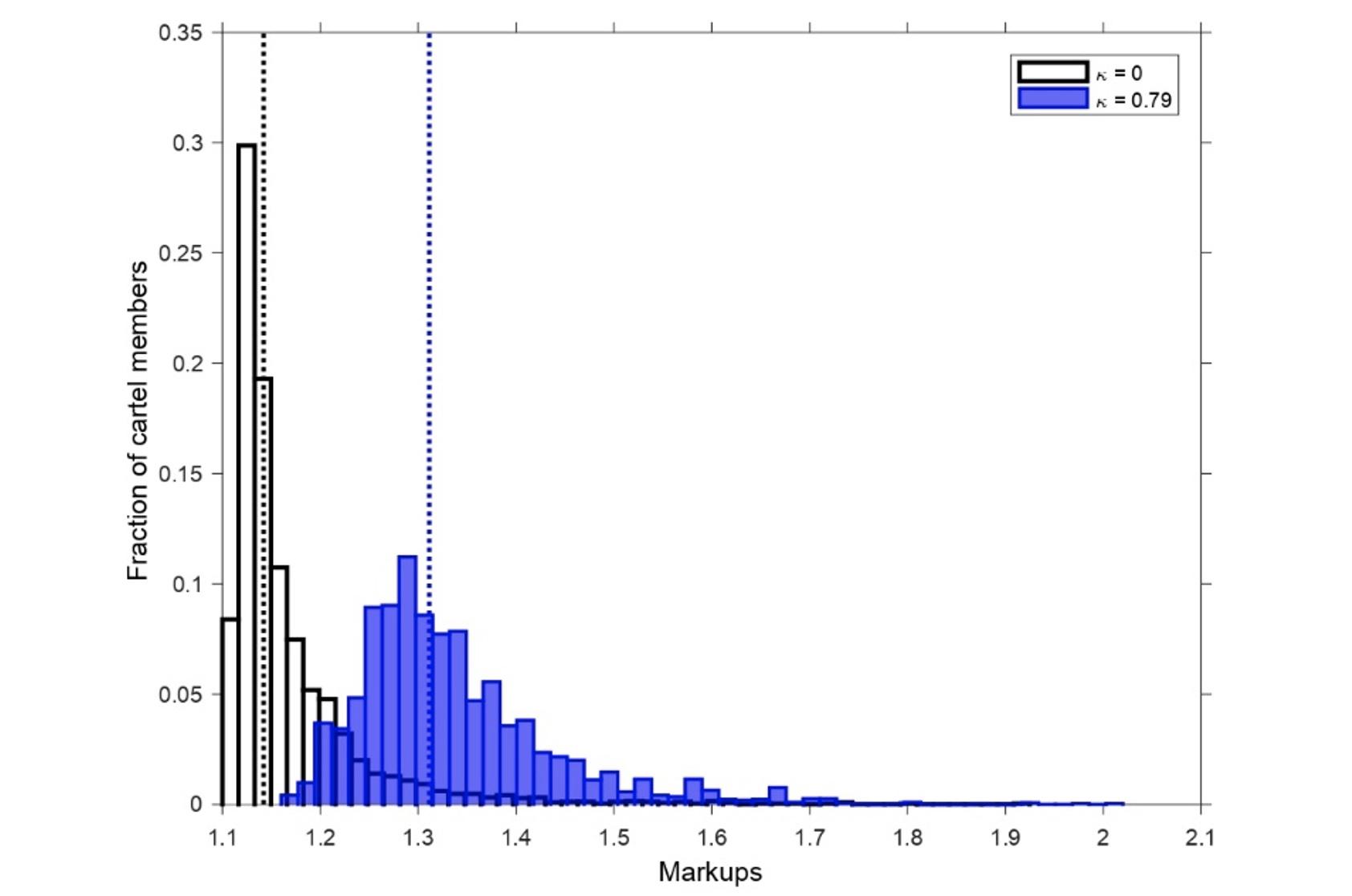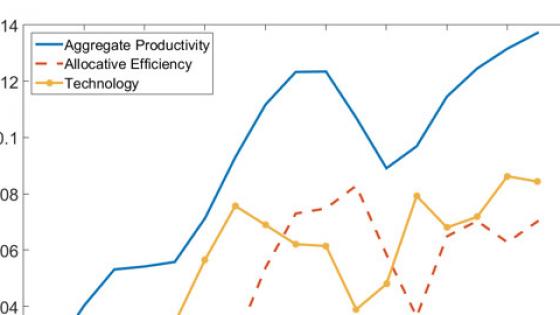As inflation broke record levels last year, spurred by food and energy supply shocks, companies have been blamed for artificially amplifying this surge and increasing their margins on top of passing input cost increases (Lagarde 2023). While corporate profits have reached historical highs (De Loecker et al. 2020) and mounting evidence suggests that markup levels are both large and rapidly growing (Edmond et al. 2022, Baqaee and Farhi 2020), there is far less agreement on the sources and economic importance of the distortions to competition-generating changes in markups.
Market power can arise from many sources, some arguably more ‘legitimate’ than others – for example, a technological edge arising from past investments, returns to scale versus changes in market structure (De Loecker et al. 2021) – and it can distort resource allocation across producers, making the economy less productive (Baqaee and Farhi 2017). Distortions to competition such as cartels are strictly illegal under competition law, and companies colluding to increase prices or restricting competition are typically fined very heavily by competition regulators.
Yet, while cartels have the potential to affect resource allocation and consumer welfare (Bridgman et al. 2015), their aggregate effects remain poorly understood.
In a recent contribution (Moreau and Panon 2022), we propose a flexible yet parsimonious approach to quantifying the macroeconomic cost of cartels, encompassing a large variety of cartel arrangements involving collusive firms of varying sizes, heterogenous markups, and spillovers to firms outside of cartels. As a result, our model allows us to integrate the empirical cartel literature with recent macroeconomic studies on the productivity and welfare costs of markups, and, crucially, to distinguish markups stemming from the unilateral exercise of market power (Edmond et al. 2022, Baqaee and Farhi 2020) from overcharges arising from collusion between firms.
Our model
Collusion can dampen or amplify existing distortions in the economy. To see this, we introduce collusion in an otherwise standard static heterogenous-firm model with oligopolistic competition (Atkeson and Burstein 2008). Heterogenous markups arise endogenously in the model: more productive firms have a larger market share in equilibrium, thereby facing a lower demand elasticity and thus charging higher markups. As in the cross-ownership framework of O’Brien and Salop (1999), cartel members internalise the effects of their production decisions on the profits of other cartel members, thereby deviating from individual profit-maximisation. Under such arrangements, cartel members collectively control a larger market share, which confers on them more market power. In equilibrium, their prices are artificially inflated as they charge supracompetitive markups (i.e. overcharges) affecting both markup dispersion and the level of the aggregate markup – which affects welfare through lower aggregate production.
Not all cartels are alike, and the amount of overcharge can vary across arrangements. This is captured in our model by a parameter that governs the extent to which cartel members internalise each other’s actions. Although this parameter is constant across firms and cartels in our benchmark results, cartel overcharges vary depending on the size of the cartel, its importance, and the number of firms operating in the industry. The collusion intensity parameter drives the amount of overcharge – a common metric used by antitrust authorities across OECD countries to assess the damage of cartels to the economy (OECD 2014). We thus use our model to conduct policy-relevant counterfactual exercises by reducing the collusion intensity or driving it all the way to zero, giving us an estimate of the cost of cartels from a macroeconomic perspective.
Importantly, the impact of cartels on aggregate productivity is not assumed in the model, but follows from the composition of detected cartels as observed in the data. In theory, by charging supracompetitive markups and restricting supply, colluding firms redirect demand towards competitive firms whose pricing decisions are less distorted. Whether this demand diversion channel is sufficient enough to counteract the negative effect of cartels on market power and increase or decrease productivity ultimately depends on the composition of cartels.
Results
We find a significant negative cost of cartels. To calibrate our model, we combine exhaustive administrative firm-level data from France over the period 1994–2007 with a novel firm-level dataset of cartels. We find that cartels are typically made up of the largest producers in their industry (in terms of sales, employment, market share, or labour productivity), which means that cartels might reallocate market shares towards less-efficient producers and depress aggregate productivity. We draw on this empirical analysis and other important data moments, such as the amount of cartel overcharge or the amount of market power in the whole economy, to discipline and estimate our macroeconomic model. As shown in Figure 1, cartel members’ markups increase and become more dispersed compared to the situation where they operate competitively (when the intensity of collusion is equal to zero).
Figure 1 Distribution of cartel members’ markups
Our main results can be summarised as follows:
- Aggregate productivity would be 1.1% higher if there were no cartels, as the intensity of the collusion parameter is reduced to zero. Intuitively, because cartel members are the top firms in their industry, breaking them down reduces markups and reallocates demand towards these large producers.
- Eliminating cartels would lead to a welfare gain of about 2%. This is because breaking down cartels would yield a decrease in the level of markups and thus a drop in the aggregate markup, increasing aggregate output and consumption.
- The cost of markups suggested in recent papers (Edmond et al. 2022) may be underestimated by a large amount.
This is because accounting for collusion generates much more misallocation to start with, increasing the distance to the efficient allocation and thus the gains from removing markup dispersion.
- Our findings challenge the received wisdom, hailing back to Harberger (1954), that the economic cost of distortions to competition may be low. We recover Harberger’s low estimate when we instead assume a sectoral version of the model with no markup dispersion across firms within industries, or when the demand elasticities are close to unity – as Harberger assumed using sectoral data. Intuitively, this is because larger elasticities of substitution generate more markup dispersion, as does relying on disaggregated data (as also recently shown by Baqaee and Farhi 2020).
- Breaking down cartels could also increase competition through a second, indirect channel. Since the presence of cartels allows non-cartel members to increase their markups and prices (as the prices of cartel members serve as an umbrella), breaking down cartels can decrease markups of non-cartel members. We find that this umbrella pricing effect dampens the aggregate gains to productivity and welfare, but that the effect is quantitatively small: not allowing non-cartel members to adjust their markups downwards would lead to a 1.14% increase in aggregate productivity instead of 1.11% for our benchmark results.
- Finally, there are gains from competition policy at the intensive margin, i.e. cartel members may respond to more vigilant antitrust scrutiny (perhaps through the threat of high fines or whistleblower tools) by reducing their collusion intensities. A decrease in the collusion intensity parameter of approximately 50% still generates gains to aggregate productivity and welfare equal to 0.5% and 0.85%, respectively.
Our results remain robust to allowing the intensity of collusion to differ across cartels, amongst other things.
Policy implications
Our model delivers an intuitive screening that can be used to detect cartels. The idea is that cartel members’ markups should correlate not only with their own market shares but also with the cartel’s market share. While our estimates may be subject to measurement error in the absence of data on firm-level prices, we find evidence that cartel market shares increase firm-level markups and that our screening delivers a value for the intensity of collusion relatively close to our benchmark value.
One policy implication stemming from our results is that antitrust enforcement and competition laws that aim to break down cartels can yield large gains. Moreover, to ensure that cartels do not form and dampen productivity gains, other policies aiming to promote economic growth, such as industrial policies or trade liberalisation reforms, may also be accompanied by robust competition laws. While collusion on the output market is costly, investigating the impact of anticompetitive practices on the input market is also a particularly fruitful area for future research (di Mauro et al. 2023).
References
Atkeson, A and A Burstein (2008), “Pricing-to-market, trade costs, and international relative prices,” American Economic Review 98: 1998–2031.
Baqaee, D and E Farhi (2017), “Aggregate productivity and the rise of mark-ups”, VoxEU.org, 4 December.
Baqaee, D R and E Farhi (2020), “Productivity and misallocation in general equilibrium,” The Quarterly Journal of Economics 135: 105–163.
Bridgman, B, S Qi and J A Schmitz (2015), “Cartels Destroy Productivity: Evidence from the New Deal Sugar Manufacturing Cartel, 1934-74”, Federal Reserve Bank of Minneapolis, Research Department.
De Loecker, J, J Eeckhout, and G Unger (2020), “The rise of market power and the macroeconomic implications,” The Quarterly Journal of Economics 135: 561–644.
De Loecker, J, J Eeckhout, and S Mongey (2021), Quantifying market power and business dynamism in the macroeconomy, NBER Technical Report.
Di Mauro, F, M Mertens, and B Mottironi (2023), “Sources of large firms’ market power and why it matters”, VoxEU.org, 17 January.
Edmond, C, V Midrigan, and D Y Xu (2022), “How Costly Are Markups?”, Journal of Political Economy, forthcoming.
Harberger, A C (1954): “Monopoly and Resource Allocation,” The American Economic Review, 77–87.
Lagarde, C (2023), “The path ahead”, speech at “The ECB and Its Watchers XXIII” conference, 22 March.
Moreau, F and L Panon (2022), “Macroeconomic Effects of Market Structure Distortions: Evidence from French Cartels”, IMF Working Paper 2022(104).
O’Brien, D P and S C SALOP (1999): “Competitive effects of partial ownership: Financial interest and corporate control,” Antitrust Law Journal 67: 559.
OECD (2014), “Guide for helping Competition Authorities assess the expected impact of their activities”.




